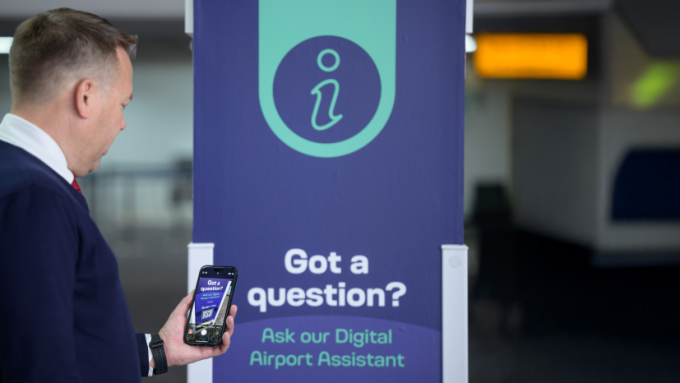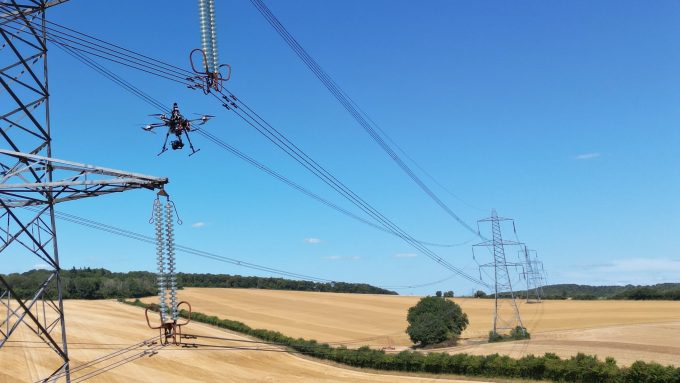
Medical drone delivery trial takes to the skies over Scotland

Interruptions from an audience mid-presentation are rarely welcomed, especially by the speaker – but there are exceptions.
With arms waving, Liam Day of Skyports Drone Services gestured to the front that the wind speed outside had suddenly dropped, and everyone – including the presenter cut off mid-sentence (who had hoped to be interrupted on this occasion) – rushed outside.
Those assembled had gathered to see a drone carrying medical specimens take off from the Royal Infirmary of Edinburgh, as part of Project CAELUS –which is looking to trial and accelerate the use of uncrewed aerial vehicles for the NHS in Scotland.
Three weeks of drone trials had taken place this summer to and from the Borders General Hospital in Melrose, some 30 miles away, followed by this showcase event at the Edinburgh BioQuarter in late August.
Delegates arriving from 6.30am had been warned that wind speeds were slightly too high for the drone to take-off at the allotted time of 7am, but that the situation would be kept under review. Forty-five minutes later, the room was rewarded for its patience.
As everyone hurried out of the seminar building and walked to a launchpad situated on a lawn opposite, there was a definite nip in the air; with tall ornamental grasses swaying in the breeze. With guests assembled on a viewing area opposite, lights on the fixed wing drone carrying a medical payload flashed red, before it suddenly shot up into the sky to a warm applause from those assembled.
Uncrewed vehicles show potential in remote areas
Drones are gaining recognition for their potential in a variety of settings, including for the delivery of vaccines in Africa, supplying materials to oil rigs in Norway, and post to residents in Orkney, explained Liam.
Inclement weather can prove to be challenging on occasion, but the wind tolerances of drones are being continually improved with larger aircraft being introduced and more powerful electric motors fitted, he added.
“This first network trial involves working with different NHS Health Boards in Scotland to deliver a range of payloads by drone. A key outcome of this activity is that it enables us to start to understand how a national drone delivery service could be provided for patients. The drone we used for the trials can fly the 30-mile route between Edinburgh and Melrose in just over half an hour.”
Liam Day of Skyports Drone Services
For normal NHS transport featuring multiple stops en-route – it should be said – a road journey through the Borders can take up to five hours.
Liam added that the next step for the project is to start to scale operations and work to unlock regulatory barriers to allow drones to fly in un-segregated airspace; integrating with other aircraft and air traffic control.
Partners convene to demonstrate medical use
Project CAELUS – namesake of the ‘god of the sky’ in Roman mythology – is working with 16 consortium partners including Connected Places Catapult and NHS Scotland to create a national drone network for Scotland to transport medicines, blood and medical equipment to remote communities.
Special permission has been granted by the Civil Aviation Authority operate the drone beyond visual line of sight in a controlled air corridor between the two hospitals in Edinburgh and Melrose.
This summer’s trials have focused on demonstrating two use cases: the transfer of laboratory samples between hospitals; and the carrying of a defibrillator on behalf of an ambulance service, landing it close to someone who has suffered a cardiac arrest and needs resuscitating.
NHS Lothian healthcare science manager Nadine Wilkinson explained that using drones to transport laboratory specimens including patient tests for analysis could help reduce the spread of infection. “Moving samples by road in rural areas with vans can be a challenge and takes time: it can be up to five hours to get a sample back and achieve a result,” she said.
A clinical scenario was explored where a patient in the Borders presented with symptoms of whooping cough, and the sample needed to be processed in Lothian. Currently, samples can be in the hands of the NHS for almost a whole day, but using a drone can allow tests to be conducted sooner and for measures to be taken quicker to treat the patient and reduce the spread of infection, she explained.

Ambulance service speaks of the opportunity
Use of drones could also play a big role in how cardiac arrests are managed in remote locations, explained Scottish Ambulance Service associate director for research and innovation Professor Paul Gowens and national research and innovation manager Adam Lloyd.
The idea is for an emergency call handler to be able to dispatch a drone carrying a defibrillator to any remote location where a person requires resuscitation, and for the person providing assistance on site to be taken through how to use the equipment via a video call.
A trial with members of the public this summer provided insight into how easily or otherwise people are able to access and use the lifesaving equipment, which will inform how drones could better be designed to accommodate defibrillators.
Reducing barriers to flight
CAELUS project director Fiona Smith from AGS Airports told the event that the drone trials forms part of a vision called ‘Opening the Skies’ to identify opportunities and barriers to flying uncrewed aircraft.
The previous Government stated its ambition to see drones operating ‘beyond visual line of sight’ by 2027, and the Civil Aviation Authority intends for airspace to be integrated in future. “The expectation is that drones and other airspace users will have equitable access,” she explained.
CAELUS innovation programme lead Hazel Dempsey added that introducing a project across 14 territorial boards for healthcare can be challenging. But several recent and upcoming flight trials as part of the project are helping to prove the technology has potential.
Future trials will be carried out between Ayrshire and Arran in the west of the country; further north between Aberdeen Royal Infirmary and Dr. Grays Hospital in Elgin; and between Dr. Gray’s Hospital and Raigmore Hospital in Inverness.
Success for the project, she adds, could mean “an enhanced logistics service in the future” for NHS Scotland, allowing more patients to stay at home and not have to travel long distances if they are feeling unwell; allowing treatments to be delivered directly to them.

Bringing stakeholders together
Connected Places Catapult’s senior systems engineer Tom Levermore says the Catapult has provided project management and engineering support to consortium partners to understand how various technologies fit together, and how the NHS and ambulance service might use drone services in future.
It has also been looking at the economics of drone deliveries and how that stacks up in terms of running services, as part of the current CAELUS project. “Rural and island communities and urban environments show a real appetite for drones – and there is an enthusiasm from stakeholders because they understand how difficult it is to deliver healthcare in challenging geographies, such as Scotland,” he said.
“We are also keen to make sure UK-based organisations are at the forefront of drone developments, and society benefits as a whole from innovation.”
Connected Places Catapult’s senior systems engineer Tom Levermore
Innovate UK’s deputy director of future flight Simon Masters spoke of the Future Flight Challenge of which the CAELUS programme is part. The challenge, he said, is “not just about developing technology for the sake of it; we are developing technology to help people”.
He added that when the challenge launched there was no focus on specific use cases, so it was “a pleasant surprise that more societally beneficial use cases have come to the fore”.
Simon said CAELUS is one of several medical drone projects under way, but said it is “recognised across Government departments and is inspiring new thinking”.
Ensuring equitable access to treatment
NHS CAELUS steering group co-chair and NHS Grampian interim chief executive, Adam Coldwells said drones promise an exciting role for medical applications and the future of health care. He added that future use cases for drones in Scotland could include innovations such as delivery of chemotherapy treatment to cancer patients in remote locations “to get the right treatment, at the right time, in the right place.”
Anne-Lise Scaillierez, a partner at The Drone Office has been working to better understand public perception about using aerial drones for medical deliveries in Scotland. “Feedback from close to 900 people across Scotland was extremely positive with around 86% supporting the use of drones for medical logistics,” she said.
“The most important benefit perceived is improving access to care for remote and rural communities.”
The 16 CAELUS consortium comprises are: AGS Airports, ANRA Technologies UK, Arup, AtkinsRéalis, Boldyn Networks UK, Commonplace Digital, Connected Places Catapult, DGP Intelsius, Dronamics, NATS, NHS Scotland, Plane Finder, Skyports Drone Services, The Drone Office, Trax International and University of Strathclyde.
Find out more about the work of Project CAELUS.
Watch a video from the flight trials.





